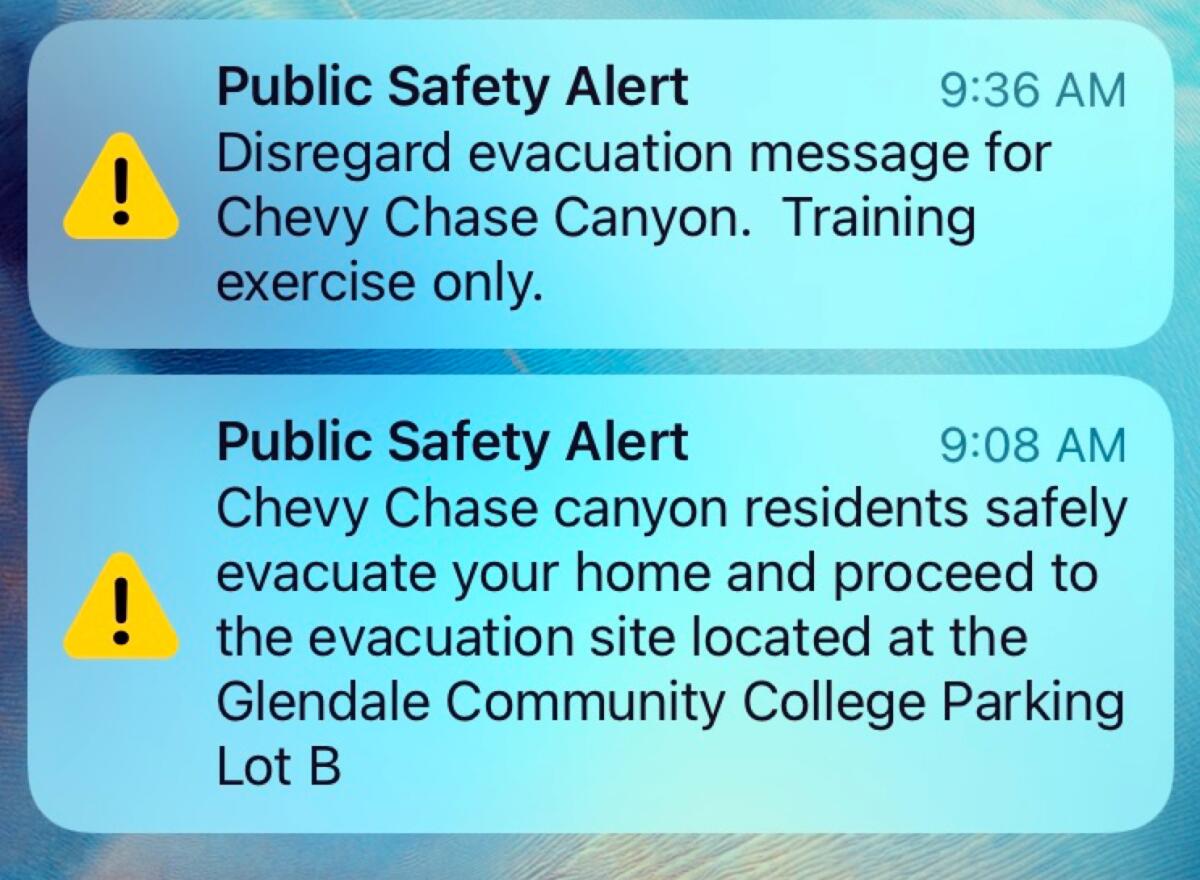Emergency alert Glendale sent by mistake sparks alarm, questions across L.A. County

- Share via
The emergency alert sent out Saturday morning startled many in Los Angeles County when it hit their smartphones with a loud alarm and vibration.
“Chevy Chase Canyon residents safely evacuate your home and proceed to evacuation site located at Glendale Community College Parking Lot B,” the alert said.
It’s unclear how many got the alert, but it was received by people as far as Long Beach and West Covina.
But there was no emergency. The alert was sent in error as part of a preplanned safety drill.
A few minutes later, Glendale sent a follow-up: “Disregard safety alert for Chevy Chase Canyon. Training exercise only.”
In a statement, city officials said: “The city conducted a planned evacuation exercise in coordination with the Chevy Chase Canyon Association. Due to a glitch in the messaging software, incorrect messaging was distributed throughout Los Angeles County. The City is working with our partners to investigate.”
Other agencies reached out to alarmed residents via Twitter: “If you received this text alert, be advised this was only A DRILL. No action required,” Pasadena said on Twitter.
Glendale Fire Chief Silvio Lanzas apologized to anyone who was negatively affected by the message and stressed that although the error in its delivery overshadowed the exercise itself, “the importance of why we conduct these drills cannot be overstated.
“As we saw last week in Laguna Niguel, our fire environment in Southern California is prime for another potentially active Fire Season,” Lanzas said in a statement. “Ensuring the community is prepared is key to keeping our residents safe.”
The way the alert program works is that officials build a polygon on a map, drawing a perimeter around the area where they want the alert to be sent, Lanzas later explained by phone. They learned today that when that perimeter has more than 100 points, the system defaults to a countywide alert. Therefore, the notification went to everyone in L.A. County who had signed up to receive training alerts, he said.
“So it wasn’t necessarily the system not working how it’s supposed to and it wasn’t operator error,” he said. “It was just the system having these parameters built within it that we were not aware of.”
The drill itself was still a success, Lanzas added — about 300 people participated, and officials believe they were residents from the area where the alert was intended to be sent. But authorities received many complaints from those who received the notification in error, he said.
“On behalf of the city of Glendale and the Glendale Fire Department and Police Department, we apologize to anybody who was negatively impacted or unnecessarily alerted and potentially startled by the mistake,” he said. “We do encourage all of our community members to remain fire wise and think about evacuations, plan for evacuations and continue to heed the warnings of fire officials.”
Emergency alerts on phones can provide lifesaving guidance for fires, floods and other disasters. But they can also go wrong. In 2018, a false alarm warning of an incoming missile was triggered by a government employee in Hawaii who got confused during an unplanned drill and thought the state was really under attack.
On Saturday morning, many were wondering what went wrong in Glendale.
“It would have been less upsetting to have woken up on fire than getting this text messages here in Pomona, great job,” one person tweeted to Glendale officials.
More to Read
Sign up for Essential California
The most important California stories and recommendations in your inbox every morning.
You may occasionally receive promotional content from the Los Angeles Times.











